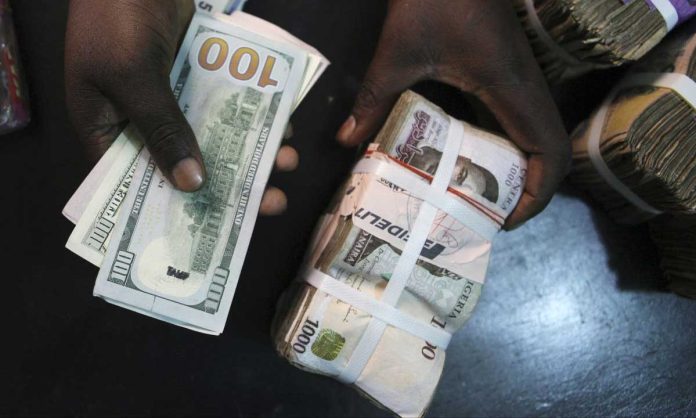The foreign exchange inflows into the Nigerian economy may further slump as the West African country is projected to suffer further decline.
PricewaterhouseCoopers International Limited (PWC) in a new report surmised that the decline in global trade growth has the tendency to adversely affect Nigeria’s trade balance in addition to FX inflows.
With the country battling to meet forex obligations despite the floating of naira, the continued disparity between the official and the parallel market is a source of concern.
According to data from FMDQ website, the naira to dollar exchange rate on Tuesday further devalued at the Investors & Exporters (I&E FX Window) as a dollar sold at N848/$ before closing at N775 on Wednesday.
The dollar exchanged for N1,100, at the parallel market, with valid fears that the worst is yet to come, going by the PWC report.
The National Bureau of Statistics (NBS) in a report last week revealed that importation of foreign currencies into Nigeria dropped to $1bn in the second quarter of 2023.
In the report, ‘Nigeria Capital Importation Q2 2023’, the NBS said the figure was a 32.9 per cent lower when compared to the $1.535bn paid into the Nigerian economy during the same period in the second quarter of 2022 and down by 9.04 percent from the 1.13bn in Q1 2023.
PWC in its Nigerian Economic Outlook for the month of October, averred that the decline in global trade growth may adversely affect Nigeria’s trade balance and FX inflows.
The report says remittance flows to low and middle-income countries is expected to remain unhinged but slow to $656 billion (2022: $647 billion), representing a 1.4 percent growth by 2023 compared to 8% growth in 2022.
The slow growth may be premised on the softening of economic activity in remittance source countries, that limited employment and wage gains for migrants.
In 2022, remittance flows to Sub-Saharan Africa was largely driven by strong remittance growth with Tanzania having 25%, Rwanda with 21%, Uganda 17%, while Ghana and Kenya had 12% and 8.5% respectively.
“Though remittances to Nigeria accounted for 38% of the total flows to the region, it increased by only 3.3% to $20.1billion”, the report says.
According to the report, a rise in the inflows of FX from autonomous or non-CBN sources, led to the widening divergence between the official and parallel market rates.
“Since 2007, the FX inflows from autonomous sources exceeded inflows from the CBN. The implication of official interventions may not accurately reflect the market demand and supply dynamics as annual inflows are skewed towards unofficial sources”, the report says.
The report says the sustained rise in public debt may negatively affect the country’s credit ratings, subsequently increasing the cost of borrowing.
“The rise in Nigeria’s public debt to N87.4 trillion in Q2 2023 could be attributed to the impact of securitisation of ways & means, and the naira devaluation.
“Foreign suppliers may not accept letters of credit amid unsettled $7 billion FX obligations to domestic lenders. This may lead to less imports of the much-needed inputs and goods for manufacturing and retail/wholesale trade, which may heighten inflationary pressures and negatively impact GDP growth.
“Nigeria debt service to revenue ratio increased to 96% in 2022 raising concerns about its widening fiscal deficit, high debt servicing to revenue and rising debt to GDP ratios.”
The report suggested five probable solutions including Boosting of Investors’ Confidence – Clear Nigeria FX Management Story; Manage for flexibility and shocks – withstand external shocks with a pocket of sequenced policy execution; Short-term fix to enhance foreign exchange liquidity; Deepening of financial markets and Longer term sectoral policy to maximise exports or deepen domestic consumption.

